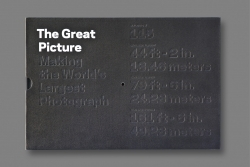The Great Picture
Making the World's Largest Photograph
- 2011 INDIES Winner
- Gold, Photography (Adult Nonfiction)
The presentation of this material alone merits a review. With an appropriate landscape (horizontal) format, and slip-cased in a tight-fitting, black-on-black embossed sleeve featuring the camera’s outlandish dimensions, the very act of opening the book signals to its readers the high level of precision required in the unusual project it documents. It appears that the scale of the eventual artifact (107’ 5“ wide x 31’ 5“ high) is equaled only by the scale of the endeavor necessary to accomplish it.
On July 8 of 2006, a panoramic image of a retired Marine Corps Air Station in Southern California was made using a gigantic jet hangar as a pinhole camera. It was the largest camera obscura ever employed. The Great Picture: Making the World’s Largest Photograph is structured as a series of chapters with provocative titles like “Size Counts” and “Is Photography Dead?” that count down episodically from the planning stages, beginning in 2002, to that date in early July.
The book details the operatic story of six energetic male artists who felt impassioned enough to record every bit of the nearly 5,000-acre, abandoned, industrial landscape for what they called The Legacy Project before it becomes the Orange County Great Park in 2017. To date, over 150,000 photographs have been archived; for the pinhole image alone, they used 600 gallons of fixer, and their projected $8,000-dollar budget for supplies soared to $65,000.
Training their aesthetic sensibilities on the past, the artists selected old-fashioned photographic methods in lieu of filmless, digital images, thereby resurrecting the tradition of photography as art while acknowledging its passage, and in the process evoking and honoring Southern California’s legacy of experimental photographers.
The gigantic picture itself is enigmatic and surprisingly lovely. Identifiable within the hazy black-and-white field are several towers, palms and cypresses, a few hangars, and the distant mountains. A function of calibration and illumination, of using the intangible in order to bring the present (a present that’s almost immediately past) to light, the piece is both high and low art, theoretical and grounded, and it embodies the full humanity of its makers. Given the value placed on process and speculation by its creators, it’s ironic, but fitting, that this document raises more questions than it answers. The picture speculates about the neutrality of the empty scene it depicts and, like the specter that slowly develops in a darkroom tray, we are left to wonder if aspects of its past as a war machine will haunt the site’s future capacity as a recreation area.
Speaking to the artistic value of their endeavor is a foreword by veteran art critic Lucy Lippard, for whom the careful account of this collective dream about attempting the improbable couldn’t be more fascinating. Readers who love the arts and science and seek inspiring stories with no short supply of wonder will agree.
Reviewed by
Julie Eakin
Disclosure: This article is not an endorsement, but a review. The publisher of this book provided free copies of the book to have their book reviewed by a professional reviewer. No fee was paid by the publisher for this review. Foreword Reviews only recommends books that we love. Foreword Magazine, Inc. is disclosing this in accordance with the Federal Trade Commission’s 16 CFR, Part 255.

